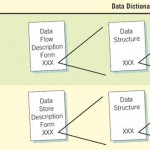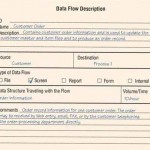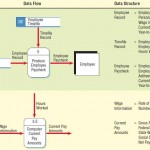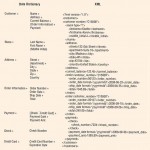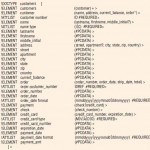After successive levels of data flow diagrams are complete, systems analysts use them to help catalog the data processes, flows, stores, structures, and elements in a data dictionary. Of particular importance are the names used to characterize data … [Read more...] about Analyzing Systems Using Data Dictionaries
Analyzing Systems Using Data Dictionaries
The Data Dictionary
The data dictionary is a specialized application of the kinds of dictionaries used as references in everyday life. The data dictionary is a reference work of data about data (that is, metadata), one that is compiled by systems analysts to guide them … [Read more...] about The Data Dictionary
The Data Repository
Although the data dictionary contains information about data and procedures, a larger collection of project information is called a repository. The repository concept is one of the many impacts of CASE tools and may contain the … [Read more...] about The Data Repository
Defining the Data Flows & Describing Data Structures
Data flows are usually the first components to be defined. System inputs and outputs are determined from interviewing, observing users, and analyzing documents and other existing systems. The information captured for each data flow may be summarized … [Read more...] about Defining the Data Flows & Describing Data Structures
Logical and Physical Data Structures
When data structures are first defined, only the data elements that the user would see, such as a name, address, and balance due, are included. This stage is the logical design, showing what data the business needs for its day-to-day operations. As … [Read more...] about Logical and Physical Data Structures
Data Elements (The Data Repository)
Each data element should be defined once in the data dictionary and may also be entered previously on an element description form, such as the one illustrated in the figure below.Characteristics commonly included on the element description form … [Read more...] about Data Elements (The Data Repository)
Data Stores (The Data Repository)
All base elements must be stored in the system. Derived elements, such as the employee year-to-date gross pay, may also be stored in the system. Data stores are created for each different data entity being stored. That is, when data flow base … [Read more...] about Data Stores (The Data Repository)
Creating the Data Dictionary
Data dictionary entries may be created after the data flow diagram has been completed, or they may be constructed as the data flow diagram is being developed. The use of algebraic notation and structural records allows the analyst to develop the data … [Read more...] about Creating the Data Dictionary
Using the Data Dictionary
The ideal data dictionary is automated, interactive, online, and evolutionary. As the systems analyst learns about the organization’s systems, data items are added to the data dictionary. On the other hand, the data dictionary is not an end in itself … [Read more...] about Using the Data Dictionary
Using Data Dictionaries to Create XML
Extensible markup language (XML) is a language that can be used to exchange data between businesses or between systems within a business. It is similar to HTML, the markup language used to create Web pages, but is more powerful. HTML is concerned … [Read more...] about Using Data Dictionaries to Create XML
XML Document Type Definitions (Data Dictionaries)
Often the element structure of XML content is defined using a document type definition (DTD). A DTD is used to determine whether the XML document content is valid, that is, whether it conforms to the order and type of data that must be present in the … [Read more...] about XML Document Type Definitions (Data Dictionaries)

